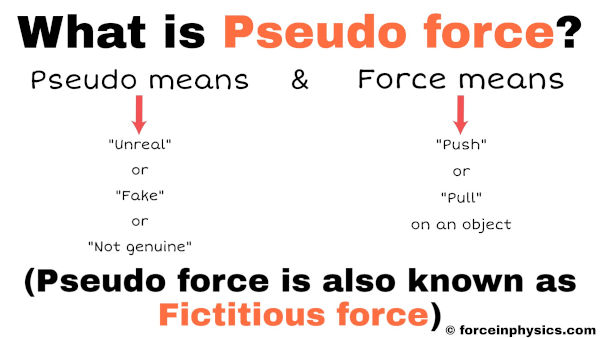
Fictitious force, also known as a pseudo force or inertial force, is an apparent force that appears to act on an object when observed from a frame of reference that is accelerating or not inertial. It creates the impression of a push or pull, even though there’s no actual physical interaction with the object. For instance, the sensation of being pushed backward when a car accelerates or pulled downward in an ascending elevator are examples of such forces. They aren’t real forces but are instead introduced by physicists and engineers to simplify calculations and explanations within accelerating reference frames.
Examples
Car speeding up
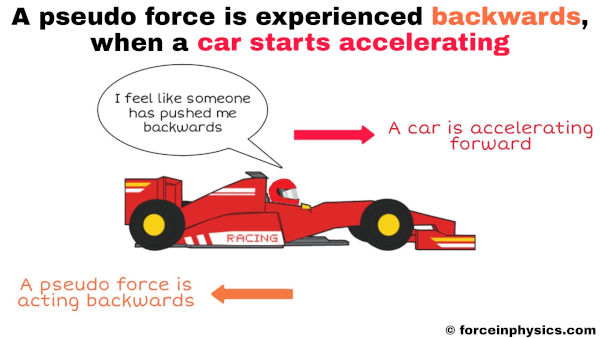
When a car accelerates, an observer inside the vehicle may sense a backward force, as if an invisible hand pushes them into their seat. This sensation results from fictitious force, specifically the ‘inertial’ or ‘pseudo’ force. No external force pushes the passenger; it’s the car’s acceleration itself. According to Newton’s first law of motion, objects stay at rest or move straight unless acted upon by an external force. As the car accelerates, the passenger tends to stay still due to their inertia. The apparent backward force arises as the car ‘drags’ the passenger along. This illustrates how fictitious forces help us understand motion in accelerating frames, despite no real external forces.
Car slowing down

When a car decelerates, an occupant might feel propelled forward, though no physical force pushes them. This perception is due to the fictitious force. In reality, it’s the car’s deceleration, not an external force, causing this. In accordance with the concept of inertia in Newton’s first law of motion, objects maintain their motion unless acted upon by an external force. As the car decelerates, the passenger’s inertia keeps them moving forward. The apparent forward force results from the car ‘slowing down’ the occupant’s motion. This demonstrates how fictitious forces clarify motion in accelerating frames without the need for real external forces.
Elevator
Accelerating upward
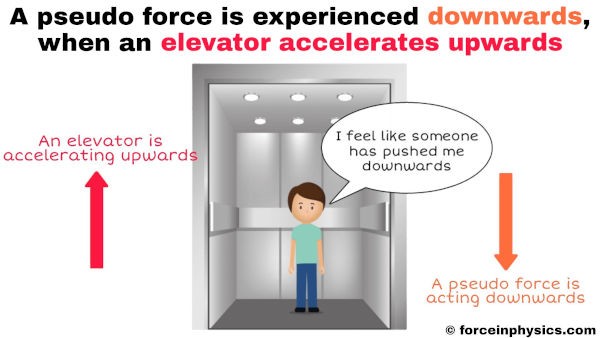
When an elevator accelerates upward, passengers inside may briefly feel a sensation of increased weight. This happens because, from their perspective inside the elevator, it appears as if a fictitious force is acting, making gravity seem stronger. In reality, gravity remains the only real force acting on passengers, constantly pulling them downward. However, when the elevator accelerates upward, passengers find themselves in a reference frame that is also undergoing acceleration. This creates the perception of an additional, or ‘fictitious,’ force pushing them downward, resulting in the feeling of greater weight. This change in apparent weight is due to the elevator’s upward acceleration, which alters how passengers perceive the effects of gravity.
Accelerating downward
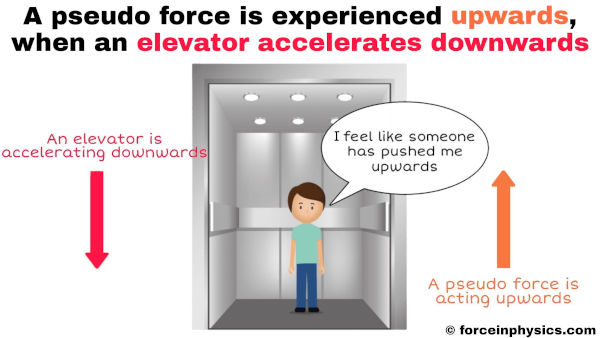
When an elevator accelerates downward, passengers may briefly feel lighter. This sensation is due to a fictitious force, which appears as a counterbalance to gravity from the passengers’ perspective within the accelerating elevator. In reality, gravity remains the sole force acting on passengers, always pulling them downward. However, as the elevator accelerates downward, it generates an apparent, or fictitious, force that gives the sensation of reduced gravity’s pull. This creates the perception of decreased weight among passengers. It’s important to note that this apparent reduction in weight is solely a consequence of the elevator’s acceleration, which changes how passengers experience the force of gravity.
Carousel
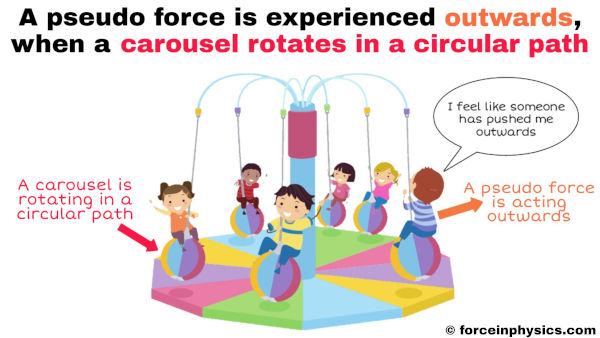
On a rotating carousel, passengers feel pushed away from the center due to the fictitious centrifugal force. In reality, there’s no outward force pushing them. Instead, it’s the carousel’s circular motion that creates this sensation. As the carousel accelerates, passengers experience an apparent force that seems to push them outward. This perceived force, solely resulting from the carousel’s rotation, changes how passengers perceive their motion.
Formula
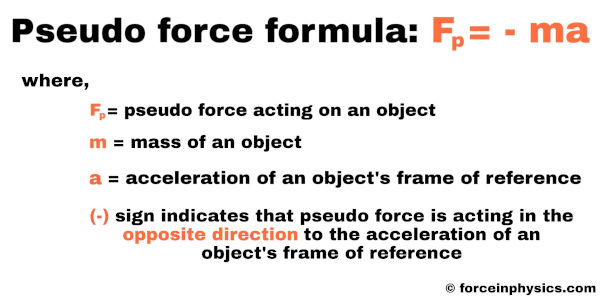
The fictitious force formula, F = -ma, helps calculate and describe the apparent forces that arise as a result of acceleration within a specific reference frame. In this formula, ‘F’ represents the fictitious force itself, and the negative sign signifies that the force acts in the direction opposite to the object’s acceleration within the reference frame. ‘m’ stands for the mass of the object, while ‘a’ indicates the acceleration of the reference frame in which the object resides.
Related
- Balanced force
- Unbalanced force
- Friction
- Tension (physics)
- Applied force
- Normal force
- Drag (physics)
- Gravity
- Centripetal force
- Centrifugal force
- Buoyancy
- Net force
- Compression (physics)
More topics
External links
- Inertial force | physics – Britannica
- Fictitious force – Wikipedia
- What is a “fictitious force”? – Scientific American
- Fictitious Forces and Non-inertial Frames: The Coriolis Force – OpenStax
- Lecture 8: Fictitious Forces and Rotating Mass – MIT OpenCourseWare
- Why is centrifugal force called fictitious? – Physics Stack Exchange
- Fictitious Forces and Non-inertial Frames: The Coriolis Force – UH Pressbooks
- Three Fictitious Forces & One Real Force – Pumps & Systems
- Fictitious force – Oxford Reference
- What is a fictitious force? – Study.com
- Is gravity a fictitious force? How so? – Quora
- fictitious force – Wiktionary
- Why do we define a fictitious (pseudo) force? – Reddit
- Fictitious force Definition & Meaning – Dictionary.com
- Science: In a spin over fictitious forces – New Scientist
- Fictitious Forces – Courtney Seligman
- Fictitious force – Wikiwand
- Fictitious Force – AK Lectures
- Fictitious force definition in American English – Collins Dictionary
- Fictitious force – DBpedia
- Fictitious force – The Free Dictionary
- Why Does a Body Experience Fictitious Force on Accelerating Objects? – Physics Forums
Deep
Forceinphysics.com was founded by Deep Rana, who is a mechanical engineer by profession and a blogger by passion. He has a good conceptual knowledge on different educational topics and he provides the same on this website. He loves to learn something new everyday and believes that the best utilization of free time is developing a new skill.
